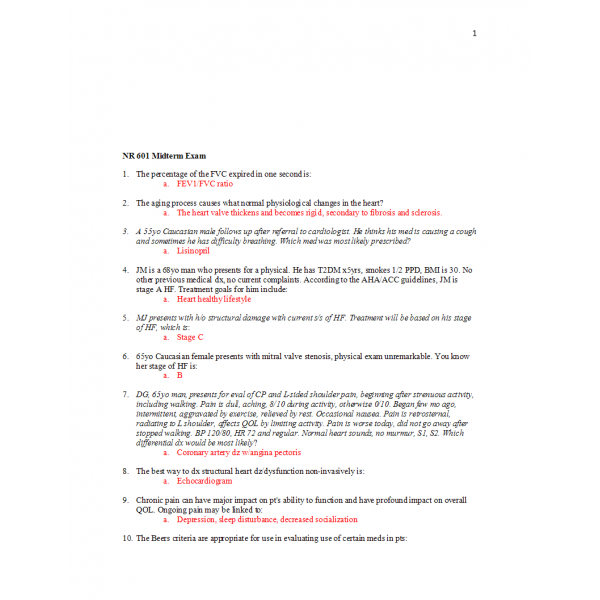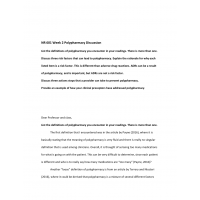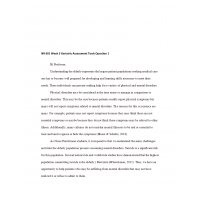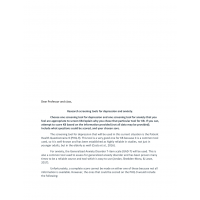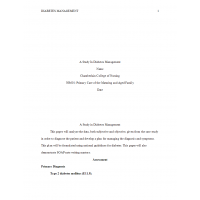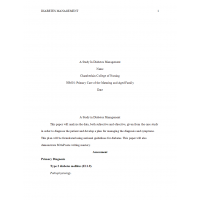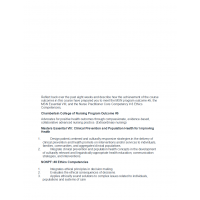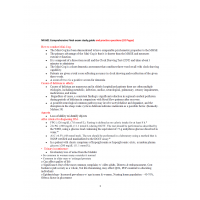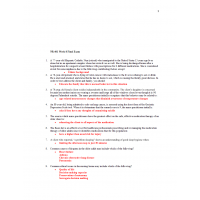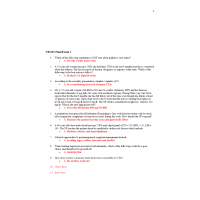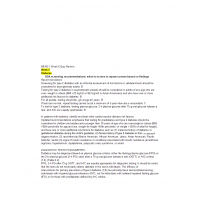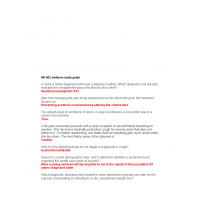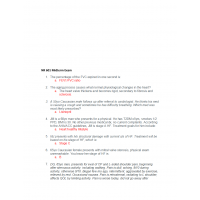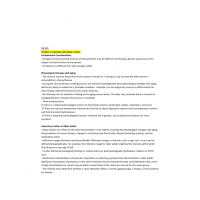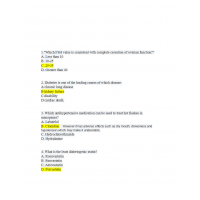- The percentage of the FVC expired in one second is:
- The aging process causes what normal physiological changes in the heart?
- A 55yo Caucasian male follows up after referral to cardiologist. He thinks his med is causing a cough and sometimes he has difficulty breathing. Which med was most likely prescribed?
- JM is a 68yo man who presents for a physical. He has T2DM x5yrs, smokes 1/2 PPD, BMI is 30. No other previous medical dx, no current complaints. According to the AHA/ACC guidelines, JM is stage A HF. Treatment goals for him include:
- MJ presents with h/o structural damage with current s/s of HF. Treatment will be based on his stage of HF, which is:
- 65yo Caucasian female presents with mitral valve stenosis, physical exam unremarkable. You know her stage of HF is:
- DG, 65yo man, presents for eval of CP and L-sided shoulder pain, beginning after strenuous activity, including walking. Pain is dull, aching, 8/10 during activity, otherwise 0/10. Began few mo ago, intermittent, aggravated by exercise, relieved by rest. Occasional nausea. Pain is retrosternal, radiating to L shoulder, affects QOL by limiting activity. Pain is worse today, did not go away after stopped walking. BP 120/80, HR 72 and regular. Normal heart sounds, no murmur, S1, S2. Which differential dx would be most likely?
- The best way to dx structural heart dz/dysfunction non-invasively is:
- Chronic pain can have major impact on pt's ability to function and have profound impact on overall QOL. Ongoing pain may be linked to:
- The Beers criteria are appropriate for use in evaluating use of certain meds in pts:
- Pt presents with c/o increasing SOB, cough w/occasional white sputum, fatigue. As part of the plan you order labs. You know the likelihood of HF is low if the BNP is:
- All of the following statements are true about lab values in older adults except:
- According to the 2017 ACC HTN guidelines, the recommended BP goal for a 65yo African American woman w/a h/o HTN and DM and no h/o CKD is:
- The pathophysiology of HF is due to:
- A 60yo woman w/30 pack yrhx, presents for eval of persistent, daily cough w/increased sputum, worse in the AM, occurring over past 3 months. She tells you, "I have the same thing year after year." Which of the following choices would you consider strongly in your critical thinking process?
- JM is a 68yo man who presents for a physical. He has T2DM x5yrs, diet controlled. His BMI is 32. He has HTN, smoker (10 cigs/day x20yrs). He denies other medical problems. Fam hx includes CAD, CABG x4 for dad, now deceased; CHF, T2DM, HTN for mom. He is asymptomatic today, exam is normal, EKG NSR. According to AHA/ACC guidelines, JM is at risk for what stage of HF?
The volume of air a pt is able to exhale for total duration of the test during maximal effort is:
- According to the 2017 ACC HTN guidelines, normal BP is:
- Functional abilities are best assessed by:
- LB is a 77yo pt w/chronic poorly controlled HTN. You know that goals include prevention of target organ damage. During your eval you will assess for evidence of:
- Aortic regurgitation requires medical treatment for early signs of HF with:
- The volume of air in the lungs at max inflation is:
- Preferred amount of exercise for older adults is:
- The total volume of air a pt is able to exhale in the first second during max effort is:
- You know the following statements regarding the pain of acute coronary syndrome are true except:
- Elderly pt presents w/new onset of feeling heart race, fatigue. EKG reveals afib w/rate >100. Pt also has a new tremor in both hands. Which of the following would you suspect?
- 62yo female c/o fatigue, lack of energy. Constipation increased, pt gained 10lbs in past 3mo. Depression is denied although pt reports lack of interest in usual hobbies. VS are WNL, skin is dry/cool. Which of the following must be included in the DD?
- Mrs. Black, 87yo, has been taking 100mcg Synthroid x10yrs. She comes for routine follow-up, feeling well. HR is 90. Your first response is to:
- Which pt is most likely to have osteoporosis?
- 80yo underweight male who smokes and has been on steroids for psoriasis
- When evaluating the expected outcome for hypothyroid elderly pt on levothyroxine, you will:
- Postmenopausal woman w/osteoporosis is taking bisphosphonate daily PO. What action info statement would indicate she understood your instructions regarding this med?
- Primary reason levothyroxine sodium is initiated at low dose in elderly pt w/hypothyroidism is to prevent which of the following untoward effects?
- 6mo ago an elderly pt was dx'd w/subclinical hypothyroidism. Today the pt returns and has TSH of 11 and c/o fatigue. He has taken Synthroid 25mcg daily as prescribed. What is the best course of action?
- A fluoroquinolone (Cipro) is prescribed for a male pt w/a UTI. What should you teach him regarding this med?
- Pt has been rx'd metformin (Glucophage). One wk later, he returns w/lowered BGL but c/o loose stools during the week. How should you respond?
- Which of the following s/s of hyperthyroidism commonly manifest in younger populations, but is notably lacking in elderly?
- 60yo obese male has T2DM and lipid panel of TC = 250, HDL = 32, LDL = 165. You teach him about his modifiable cardiac risk factors, which include:
- Diabetic pt presents w/R foot pain but denies any recent known injury. He states it has gotten progressively worse over past few months. On exam, vibratory sense, as well as sensation tested w/monofilament, was abnormal. Pt's foot is warm, edematous, misshapen. You suspect Charcot foot. What intervention is indicated?
- What is a s/s of insulin resistance that can present in African Americans?
- During routine exam of 62yo female, you ID xanthelasma around both eyes. What is the significance of this?
- Mr. White is 62yo, had CKD that has been relatively stable. He also has h/o hyperlipidemia, OA, HTN. He is compliant w/meds, BP has been well controlled on CCB. Last lipids showed: TC = 201, HDL = 40, TG = 180, LDL = 98. He currently takes Crestor 20mg daily. Today his BP is 188/90 and urine dip shows significant proteinuria. He denies changes in dietary habits or med regimen. What would be the best med change at this point?
- You are working as NP in Fast Track of ER. 76yo male presents w/LUQ pain. There can be many conditions that present as LUQ pain, but which of the following is least likely to cause pain here?
- Which is cardinal feature of failure to thrive?
- Feeding gastrostomy tubes at end-of-life Alzheimer's pt's have been associated with:
- Which of the following nutritional indicators is not an indication of poor nutritional status in elderly?
- OA of cervical and lumbar spine causes pain related to all of the following except:
- In differentiating OA from chronic gout, pseudogout, or septic arthritis, the most valuable diagnostic study would be:
- Pt's w/OA of hip and knee often have distinguishable gait described as:
- Which of the following best describes pain associated w/OA?
- Joint effusions typically occur later in the course of OA, especially in the:
- You ordered CBC for your pt you suspect has polymyalgia rheumatica (PMR). Which 2 clinical findings are common in pt's w/PMR?
- You suspect your pt has PMR and now are concerned that they may have Giant Cell Arteritis (GCA) too. Which of the following 2 symptoms are most indicative of GCA and PMR?
- 63yo Caucasian pt w/PMR will begin Tx w/corticosteroids until the condition has resolved. You look over her records and it has been 2yrs since her last physical exam and any labs or diagnostic tests as she relocated and had not yet ID'd a provider. In prioritizing your management plan, your first orders should include:
- Which of the following DD for pt's presenting w/PMR can be ruled out w/a muscle biopsy?
- In reviewing lab results for pt's w/suspected PMR, you realize there is no definitive test to dx PMR, rather clinical response to Tx. Results you would expect to see include:
- Which of the following is the most appropriate lab test for monitoring gout therapy over the long-term?
- In providing health teaching related to dietary restrictions, you should advise a pt w/gout to avoid which of the following dietary items:
- The best method of verifying gout dx in a joint is which of the following:
Joint aspiration and polarized-light microscopy
The most appropriate first-line Tx for acute gout flare is (assuming no kidney dz or elevated bleeding risk):
- You order bilat wrist XR on 69yo man c/o pain both wrists x6 wks no related to any known trauma. You suspect early onset RA. The initial XR finding in a pt w/elderly onset RA would be:
- Soft tissue swelling
- A 72yo female has been dx'd w/gout. She also has h/o chronic HF. The most likely contributing factor to development of gout in this older female is:
- Which of the following statements about OA is true?
It affects primarily wt-bearing joints
In considering the specificity of lab data, the most reliable diagnostic test listed below would be:
- When examining the spine of an older adult you notice a curvature w/a sharp angle. This is referred to as a:
- The prevalence of depression in nursing home residents is ___________ greater than adults living in the community.
- The majority of depressed older adults remain untreated because of:
- Symptoms of depression distinct to the elderly include:
- The justification for ordering CBC, TSH, serum B12 for a pt you may suspect have clinical depression is:
- One major difference that is useful in the DD of dementia versus delirium is that:
- Which of the following is the most appropriate screening tool for delirium?
- The proposed mechanism by which diphenhydramine causes delirium is:
- The elderly are at high risk for delirium because of:
- A consistent finding in delirium, regardless of cause, is:
- Older adults w/dementia sometimes suffer from agnosia, which is defined as the inability to:
- In late stages of dementia, a phenomenon called sun downing occurs, in which cognitive disturbances tend to:
- Of the following, which one is the most useful clinical eval tool to assist in the dx of dementia?
- The cornerstone of pharmacotherapy in treating Alzheimer's is:
- The comorbid psych problem w/the highest frequency in dementia is:
- When treating depression associated w/dementia, which of the following would be a poor choice and should not be prescribed?
- Which of the following should be avoided in countries where food and water precautions are to be observed?
- What insect precautions are not necessary to prevent insect-borne dz's in the tropics?
- An example of secondary prevention you could recommend/order for older adults would be to:
- Ali is a 72yo man who recently came to US from Nigeria. He reports having BCG (bacille Calmette-Guerin) vax as a child. Which of the following is correct regarding a TB skin test?
- Leo is a 62yo African American male who comes in for an initial visit. Personal health hx includes smoking 1 PPD since 11yo, consuming a case of beer (24 bottles) every weekend, and working as an assembler (sedentary job) for the past 10yrs. Fam Hx in first-degree relatives includes HTN, high cholesterol, MI, T2DM. Leo's BMI is 32. BP is 130/86. You order fasting glucose, lipid profile, and return visit for BP check. This is an example of:
- A local chapter of NP organization has begun planning a community-based screening for HTN at a local congregate living facility. This population was selected on the basis of:
- Performing ROM exercises on a pt who has had a CVA is an example of which level of prevention?
- You demonstrate an understanding of primary prevention of falling among the elderly through which management plan?
- An example of an active strategy of health promotion for an individual to accomplish would be:
- The 4 main domains of clinical preventive services that you will provide are:
- What is the appropriate method for TB screening of an older adult entering a nursing home?
- Meds known to contribute to constipation include all of the following except:
- All of the following are considered contributors to dysphagia except:
- The term "geriatric syndrome" is best described as:
- The anal wink reflex is used to test:
- Atypical presentation of acute coronary syndrome is:
- What dz can mimic and often co-exists w/MI in elderly w/CAD?
- Thoracic aortic dissection presents typically as:
- Bordetella pertussis is best characterized by:
- Routine testing of TB should occur in all of the following vulnerable populations except:
- Which of the following statements about fluid balance in elderly is false?
- Distinguishing delirium from dementia can be problematic since they may co-exist. The primary consideration in the DD is:
- Presbystasis is best described as:
- If dizziness has a predictable pattern associated w/it, you should first consider:
- Evidence shows that the most important predictor of a fall is:
- The most cost-effective interventions used to prevent falls are:
- Chronic fatigue syndrome is best described as:
- Which form of HA is bilat?
- Microscopic hematuria is defined as:
- Risk factors associated with the finding of a malignancy in a pt w/hemoptysis include all of the following except:
- Recent wt loss is defined as:
- The most common cause of disability in elderly is due to:
- Lipedema is best described as:
- Drug-induced pruritis is distinguished because it:
- May occur right after drug is taken or months later
- A form of syncope that is more common in elderly than in younger adults is:
- All of the following statements about tremor are true except:
- Overflow incontinence is usually associated with:
- Wandering is best described as:
- A key symptom of ischemic heart dz is CP. However, angina equivalents may include exertional dyspnea. Angina equivalents are important because:
- Which test is clinical standard for assessment of aortic stenosis?
- Ischemic heart dz is:
- Preceding a stress test, the following lab work might include:
- On exam, what type of murmur can be auscultated w/aortic regurg?
- Which of the following statements is true regarding anti-arrhythmic drugs?
- In mitral stenosis, p waves may suggest:
- Aortic regurg requires medical tx for early signs of CHF with:
- The best evidence rating drugs in a post-MI pt include:
- 55yo post-menopausal woman with h/o HTN c/o jaw pain on heavy exertion. No c/o CP. EKG is
- What is the most common valvular heart dz in elderly?
- Elderly may present with atypical clinical signs of pna. You need to be aware that clustering of all of the following s/s may indicate pna in the elderly except for:
- A common auscultatory finding in CHF is:
- The most common organism responsible for CAP in the elderly is:
- 72yo woman and her husband are driving cross-country. After a long day of driving, they stop to eat. Midway through the meal, the woman becomes very SOB w/CP and a sense of panic. Which problem is most likely?
- Exercise recommended for elderly should include activities that:
- Preferred amount of exercise for elderly is:
- Which of the following medical conditions is not considered restrictive for engaging in physical activity?
- The best recommendation for a pt who says they have no equipment to exercise is:
- When you recommend exercise for elderly, which of the following pieces of advice should be considered for all types of exercise?
- All of the following statements are true about lab values in the elderly except:
- Biochemical individuality is best described as:
- All the following statements about drug absorption are false except:
- The cytochrome p system involves enzymes that are generally:
- A statement not shown to be true about pharmacodynamic changes with aging is:
- The major impact of the physiological changes that occur w/aging is:
- The strongest evidence regarding normal physiological aging is available through:
- Pharmacokinetic changes w/aging is reflective of:
- All of the following statements are true about drug distribution in the elderly except:
- Men have faster and more efficient biotransformation of drugs and this is thought to be due to:
- Atypical presentation of dz in elderly is reflected by all the following except:
- Polypharmacy is best described as taking:
Institution & Term/Date
Term/Date
Chamberlain University
NR 601 Week 4 Midterm Exam 2
- Product Code: 2021
- Availability: In Stock
-
$30.00
Related Products
NR 601 Week 7 Reflection
$10.00
NR 601 Week 8 Final Exam 2
$35.00
NR 601 Week 8 Final Exam 1
$35.00
NR 601 Week 6 Quiz Review
$20.00
NR 601 Week 4 Midterm Exam 1
$30.00
NR 601 Final Exam Study
$30.00

